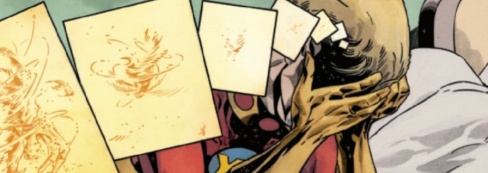There are a lot of comics out there, but some stand out head and shoulders above the pack. With “Don’t Miss This,” we want to spotlight those series we think need to be on your pull list. This week, we’re spotlighting the return of “Miracleman.” Marvel is finally continuing the story of Michael Moran from the original creators of Neil Gaiman and Mark Buckingham after the series abrupt cancellation in 1993. Find out why you can’t miss the latest adventures of Moran in our Don’t Miss This for “Miracleman: The Silver Age.”

Who’s this by?
“Miracleman: The Silver Age” is written by Neil Gaiman. Gaiman is a beloved creator in comics thanks to the work Gaiman did with DC’s Vertigo Imprint. Gaiman first worked on the “Black Orchid” series with Dave McKean. Vertigo staff member Karen Berger gave Gaiman the task to resurrect the Sandman character. Gaiman collaborated with Dave McKean on the “Sandman” series to work on the covers. Artist Sam Kieth was the first artist on the “Sandman” series with Gaiman. “Sandman” grew to immense popularity and cemented Gaiman’s reputation in the comic book medium. Gaiman went on to write a special Batman story with art from Andy Kubert titled “Batman: Whatever Happened to the Caped Crusader?” as well as “Marvel 1602” by Andy Kubert. After leaving Miracleman behind for such a long time, Marvel is finally giving Gaiman the chance to return to his story.
Mark Buckingham’s first work at Marvel is credited as the cover artist for “Doctor Strange Sorcerer Supreme Annual” #4 in 1992 according to Marvel.com! Buckingham then moved over to draw the covers for “Generation X” alongside Chris Bachalo with writer Scott Lobdell. After drawing several odds and ends for Marvel, Willingham went onto to draw the landmark “Fables” title with Bill Willingham for over 100 issues of content. Now Buckingham is returning with Gaiman to finish off their Miracleman run that kicked off years ago!
What’s it all about?
Michael Moran rose to prominence to serve as the ruler of a new Golden Age. Will Moran be able to rule over his people with kindness or has the power of a despot corrupted the once heroic Miracleman?
What makes it so great?

The aspect that makes Miracleman great for me lies in the subtext of any given issue of the series. The subtext is communicated by Neil Gaiman’s writing in some moments and by Mark Buckingham’s art in other moments. In “Miracleman” #0 Gaiman uses Moran’s prose to reflect on the nature of art, dancing and literature. Moran in the space of a comic book is reflecting on the greatness that comic books can achieve. While Moran is cycling through these thoughts, Moran is picturing himself dancing amid beautiful architecture while picturing himself speaking with Dolphins. The seemingly irreverent subject matter makes the series deceptively complicated despite a simple presentation.

“Miracleman” #17 or “Miracleman: The Golden Age” #1 is a strong moment for Gaiman and Buckingham. Gaiman and Buckingham open the issue by commenting on Alan Moore’s run with a strong level of subtext captured from an image alone. Buckingham’s expansive art in this series has gone on to inform the newest issues of the comic, carrying even more details than previous installments. The conclusion of this issue is another incredibly dark sequence perfectly captured from the strong pacing with Buckingham’s art and incredibly morose writing from Gaiman.
“Miracleman: The Silver Age” #1 features an incredibly redrawn sequence from Buckingham. Young Miracleman attempts to find consciousness after being lost to time for so long. The way that Buckingham interprets this difficult moment for Dickie Dauntless using symbolism like planes and retro iconography is stunning. Jordie Bellaire’s colors add a whole new dynamic to the series that makes it clearer than ever before.
During the previous run of Miracleman, Neil Gaiman took the book in some really dark directions. Gaiman explored the dangerous lives that humans living in a despotic Miracleman-world are now subject to. The dark way that Gaiman explored Miracleman’s project with young children was a chilling read that showed off just creative Gaiman can get in picturing this fractured reality that Miracleman plunged the world into. Gaiman even utilizes these characters that he spent time establishing for the new and old version of “Miracleman” #23.
Continued below
The run on “Miracleman” is able to utilize so many nuances from the last run to improve the series. In the first issue of “Miracleman: The Silver Age,” the team mentions the fight that capped off the last run having a major impact on the series. The way that Dickie Dauntless responds to this in the debut issue is troubled yet interesting. One worry I have with the series at large is where exactly Gaiman can go with this storyline. It seems like Gaiman has a natural urge to turn Moran into a darker character. So far, Gaiman has definitely hinted that the judgment system of Moran is flawed but he has also tried to create a strong sense of empathy with others. Moran does not choose to lie to Dickie but tells him the ugly truth. This razor-sharp focus on characterization at such a nuanced level is really the main draw of the series to-date. I hope going forward, Gaiman and the team at Marvel will continue to utilize this attention to characterization that makes “Miracleman” feel different from the other comics on the store shelf.
How can you read it?
You can purchase “Miracleman: The Silver Age” monthly from Marvel Comics wherever finer issues are sold. Marvel Comics just published a Miracleman Omnibus collecting Alan Moore, Garry Leach and more’s incredibly run on the series!






